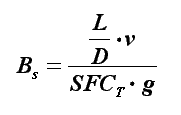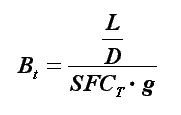| Airplane Type | Takeoff | Climb | Descent | Landing |
|---|---|---|---|---|
| 1. Homebuilts | 0.998 | 0.995 | 0.995 | 0.995 |
| 2. Single Engine | 0.998 | 0.992 | 0.993 | 0.993 |
| 3. Twin Engine | 0.996 | 0.990 | 0.992 | 0.992 |
| 4. Agricultural | 0.996 | 0.998 | 0.999 | 0.998 |
| 5. Business Jets | 0.995 | 0.980 | 0.990 | 0.992 |
| 6. Regional TBP | 0.995 | 0.985 | 0.985 | 0.995 |
| 7. Transport Jets | 0.995 | 0.980 | 0.990 | 0.992 |
| 8. Military Trainers | 0.990 | 0.980 | 0.990 | 0.995 |
| 9. Fighters | 0.990 | 0.96-0.90 | 0.990 | 0.995 |
| 10. Mil. Patrol, Bomb and Transport | 0.995 | 0.980 | 0.990 | 0.992 |
| 11. Flying Boats, Amphibious and Float Airplanes | 0.996 | 0.985 | 0.990 | 0.990 |
| 12. Supersonic Cruise Airplanes | 0.995 | 0.92-0.87 | 0.985 | 0.992 |
| Notes: 1. The numbers in this table are based on experience or on judgement. 2. There is no substitute for common sense! If and when common sense so dictates, the reader should substitute other values for the fractions suggested in this table. | ||||
|
|
The mass fractions are calculated with the Breguet factor:
 and
and 
where the cruise distance respectively range sCR is a given requirement,
and the Breguet factors are:
 and
and  .
.
v is the cruise speed and a given requirement;
the specific fuel consumption SFCT is depending on the engines and given or chosen from statistics.
| engine | CFM 56-5A | CFM 56-5C | IAE V 25xx | JSC PS90A | PW 305A | PW 2xxx | PW 4xxx | PW JT9D | RB 211 | RR Trent 800 | ZMKB D-18T | |
|---|---|---|---|---|---|---|---|---|---|---|---|---|
| SFCT | in [mg/N/s] | 16.87 | 16.06 | 16.26 | 17.84 | 19.29 | 15.95 | 15.21 | 17.42 | 16.15 | 15.77 | 16.142 |
| in [lb/h/lb] | 0.596 | 0.567 | 0.575 | 0.630 | 0.681 | 0.563 | 0.537 | 0.615 | 0.570 | 0.557 | 0.570 | |
| in Aircraft | A320, A319 | A340 | A319, A320, MD90 | TU204 | Learjet 60 | B757, IL96 | B777, MD11, A330 | A310, B767 | B777, B747 | B777 | AN124, AN225 | |
The loiter time t is determined in the FAR depending on the range.
Short and middle range:
FAR Sec. 125.377 Fuel supply: Turbine-engine-powered airplanes other than turbo-propeller.
(a) Except as provided in paragraph (b) of this section, no person may
release for flight or takeoff a turbine-powered airplane (other than a
turbopropeller-powered airplane) unless, considering the wind and other
weather conditions expected, it has enough fuel--
(1) To fly to and land at the airport to which it is released;
(2) Thereafter, to fly to and land at the most distant alternate airport
specified in the flight release; and
(3) Thereafter, to fly for 45 minutes at normal cruising fuel consumption.
FAR Sec. 125.377 Fuel supply: Turbine-engine-powered airplanes other than turbo-propeller.
(b) For any operation outside the 48 conterminous United States and the
District of Columbia, unless authorized by the Administrator in the
operations specifications, no person may release for flight or take off a
turbine-engine powered airplane (other than a turbopropeller-powered
airplane) unless, considering wind and other weather conditions expected, it
has enough fuel--
(1) To fly and land at the airport to which it is released;
(2) After that, to fly for a period of 10 percent of the total time
required to fly from the airport of departure and land at the airport to
which it was released;
(3) After that, to fly to and land at the most distant alternate airport
specified in the flight release, if an alternate is required; and
(4) After that, to fly for 30 minutes at holding speed at 1,500 feet above
the alternate airport (or the destination airport if no alternate is
required) under standard temperature conditions.
|
|